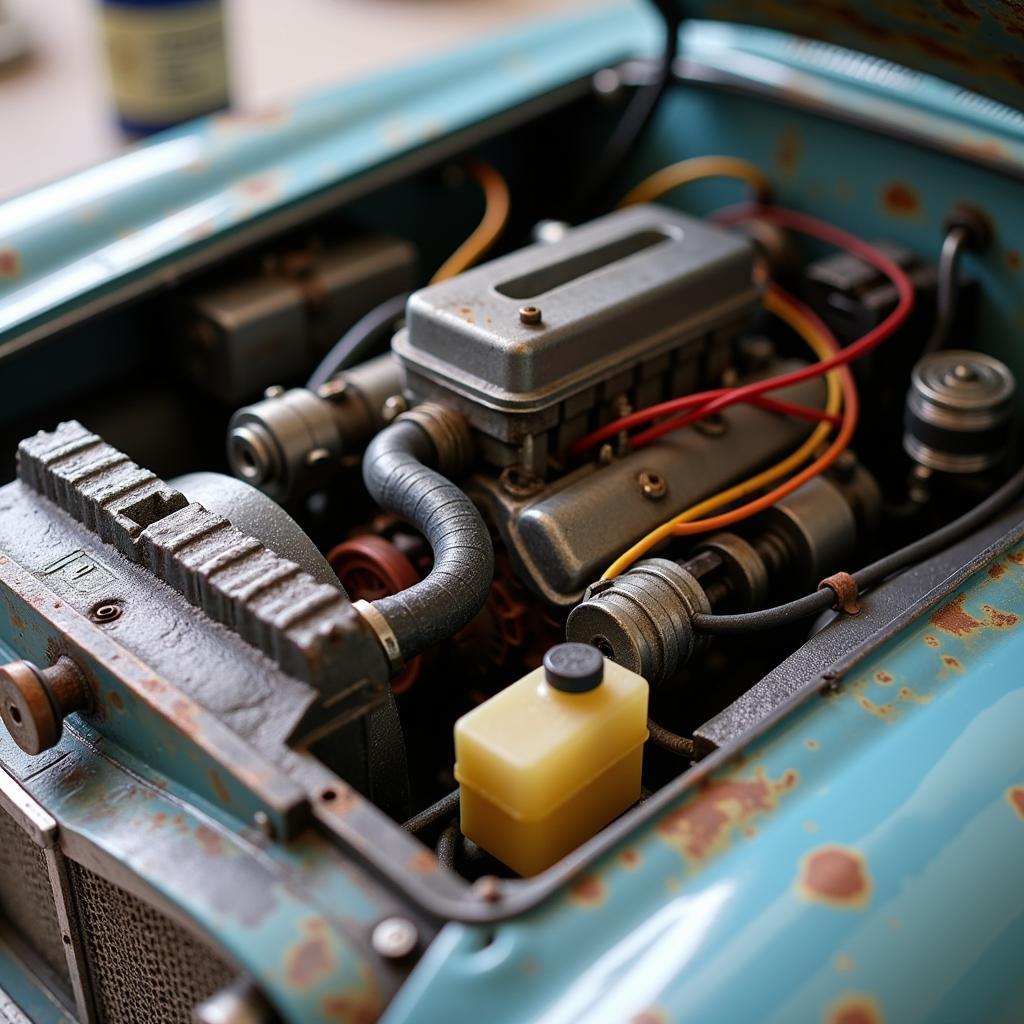Detailing the engine bay of a scale model car can elevate its realism and overall presentation. This guide provides a step-by-step approach on How To Detail Paint Engine Bay On Scale Model Car, transforming it from a basic representation to a miniature masterpiece.
Preparing the Engine Bay for Detailing
Before applying any paint or details, meticulous preparation is crucial. This ensures a smooth surface for the paint to adhere to and enhances the final result. Start by carefully removing any mold lines or imperfections using a sharp hobby knife or fine sandpaper. Clean the engine bay thoroughly with a mild soap and water solution, ensuring all dust and debris are removed. Rinse thoroughly and allow to dry completely. A primer layer is often beneficial, especially when working with resin or metal models, as it promotes better paint adhesion and prevents chipping.
After the primer is dry, consider what kind of finish you’re aiming for. Do you want a factory-fresh sheen or a weathered, more realistic look? This will inform your paint choices and techniques. Now is also the time to consider masking off areas you don’t want to paint, such as bolt heads or specific engine components. Precision in this stage will pay dividends later.
Just like professional car detailers who understand the importance of preparation, taking the time to properly prepare the engine bay of your scale model will result in a more professional and satisfying outcome. Even small details, like ensuring a clean surface, can greatly impact the final look.
Painting the Engine Bay
With the engine bay prepared, the painting process begins. Choose high-quality acrylic or enamel paints specifically designed for models. These paints offer excellent coverage and durability. Thin the paint according to the manufacturer’s instructions, as this ensures smooth application and prevents clogging of the airbrush or brush. Multiple thin coats are preferable to a single thick coat, as this minimizes the risk of runs and uneven coverage.
Consider the actual car engine as a reference. Research images of the specific engine you are replicating to ensure accurate color representation and placement of details. If using an airbrush, maintain a consistent distance and air pressure for even coverage. For smaller details, a fine-tipped brush is ideal. Allow each coat of paint to dry thoroughly before applying the next.
Remember, professional detailing isn’t just about shiny paint. It’s about precision and attention to detail. Want to know which manufacturer detailed HO slot cars? Check out our dedicated article.
Adding Details and Weathering
After the paint has dried completely, it’s time to add the intricate details that bring the engine bay to life. These details can range from tiny wires and hoses to decals and washes. Use tweezers and a magnifying glass for precise placement of small parts. A steady hand and patience are key. For wiring, use fine-gauge wire and carefully route it following reference photos. Secure the wires with a small drop of super glue or cyanoacrylate adhesive.
For a more realistic look, consider adding weathering effects. A wash of thinned black or brown paint can simulate oil stains and grime. Dry brushing with metallic paints can highlight raised edges and create a worn appearance. A subtle dusting of weathering powders can add a final touch of realism.
Knowing how much professional car detailers make might surprise you. The skills involved in detailing translate well into this meticulous hobby. For insights into this profession, check out our article on how much professional car detailers make.
 Adding Details and Weathering to a Scale Model Engine Bay
Adding Details and Weathering to a Scale Model Engine Bay
Conclusion
Detailing the paint engine bay on a scale model car is a rewarding process that transforms a simple model into a miniature work of art. By following these steps and dedicating time and patience, you can achieve a level of realism that will impress even the most discerning eye. Remember, the key is preparation, precise painting, and careful attention to detail. So, grab your tools, choose your paints, and start detailing! Check out which manufacturer detailed slot cars for further inspiration.
FAQ
-
What type of paint is best for detailing scale model engine bays?
High-quality acrylic or enamel paints designed for models are recommended. -
How do I prevent runs when painting the engine bay?
Apply multiple thin coats and allow each coat to dry thoroughly. -
What tools are essential for adding details to the engine bay?
Tweezers, a magnifying glass, and fine-tipped brushes are essential. -
How can I create a realistic weathered look?
Use washes, dry brushing, and weathering powders to simulate wear and tear. -
Where can I find reference photos for detailing my engine bay?
Online resources, books, and magazines are excellent sources of reference photos. -
What is the best way to clean my model before painting?
Use a mild soap and water solution and a soft brush. -
How do I choose the right paint color for my engine bay?
Research the specific engine you are replicating for accurate color representation.

Leave a Reply